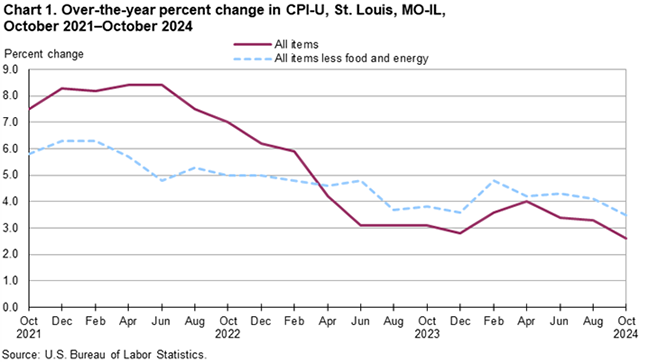KANSAS CITY – Prices in the St. Louis area, as measured by the Consumer Price Index for All Urban Consumers (CPI-U), declined 0.7% for the two months ending in October 2024, the U.S. Bureau of Labor Statistics reported today. Assistant Commissioner for Regional Operations Michael Hirniak noted that the October decrease was most influenced by a 14.4-percent fall in prices for energy. The all items less food and energy index rose 0.4%, while food prices also increased 0.4%.
Over the last 12 months, the CPI-U advanced 2.6%. The index for all items less food and energy was up 3.5% over the year, and the food index rose 2.1%. The energy index declined 6.3%, almost entirely the result of a decrease in the index for gasoline. (See chart 1.)

Food
Food prices increased 0.4 percent for the two months ending in October. Prices for food at home (grocery store prices) advanced 0.7 percent, led by a 2.1-percent rise in the other food at home index. Prices for food away from home (restaurant, cafeteria, and vending purchases) were up 0.1 percent for the same period.
Over the year, food prices rose 2.1 percent. Prices for food away from home increased 4.2 percent since a year ago, and prices for food at home advanced 0.8 percent.
Energy
The energy index declined 14.4 percent for the two months ending in October. The decrease was mainly due to lower prices for electricity (-27.4 percent), but a 10.4-percent fall in gasoline prices also contributed. The index for natural gas service advanced 2.5 percent for the same period.
From October 2023 to October 2024, energy prices declined 6.3 percent. This was almost entirely due to lower prices for gasoline (-14.8 percent), but a 1.1-percent decrease in prices paid for electricity also contributed. The index for natural gas service rose 10.6 percent during the past year.
All items less food and energy
The index for all items less food and energy increased 0.4 percent in the latest two-month period. Higher prices for shelter (+1.1 percent) drove almost all of the advance, along with rising costs for medical care services, as well as recreation (+1.1 percent). These increases were partially offset by lower prices for education and communication (-2.9 percent), household furnishings and operations (-2.2 percent), and medical care commodities.
Over the year, the index for all items less food and energy was up 3.5 percent. Components contributing most to the rise included shelter (+7.5 percent) and medical care services. Partly offsetting the increases were price decreases in education and communication (-3.9 percent) and new and used motor vehicles (-2.5 percent).
